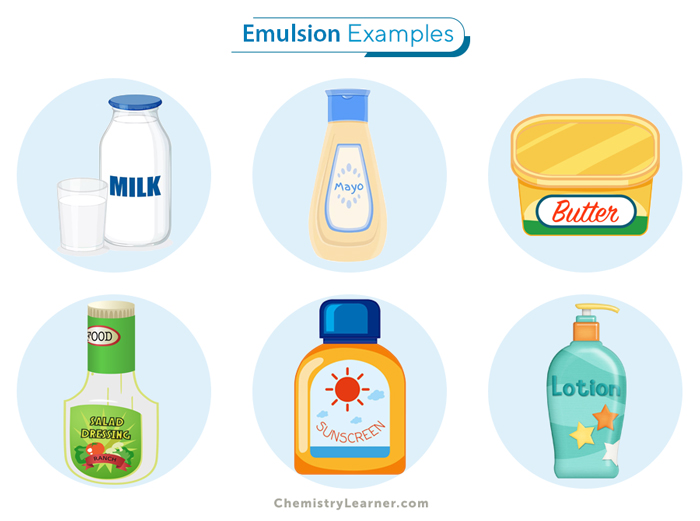Emulsion
An emulsion is a mixture of two or more liquids that are usually immiscible with each other. An emulsion consists of two main components: the dispersed phase and the continuous phase. The dispersed phase consists of tiny droplets or particles of one liquid suspended within another liquid, which is the continuous phase. These droplets are stabilized by emulsifiers that help prevent them from coalescing or separating. [1-4]
Types of Emulsion
Emulsion can come in various forms, such as water-in-oil (w/o) or oil-in-water (o/w), depending on which liquid is dispersed within the other. [1-4]
1. Water-in-Oil (w/o) Emulsion
In a water-in-oil emulsion, water droplets are dispersed in an oil phase. This emulsion type is commonly used in skincare products like creams and lotions. It provides a protective barrier on the skin and prevents moisture loss. Butter and margarine exemplify w/o emulsions.
2. Oil-in-Water (o/w) Emulsion
Conversely, an oil-in-water emulsion consists of oil droplets dispersed in a water phase. This emulsion type is often found in moisturizing lotions and liquid foundations. It is lightweight, easy to spread, and absorbs quickly into the skin. Milk is a notable illustration of an o/w emulsion, wherein fat globules (dispersed phase) are present in water (dispersing medium).
Examples
Emulsions play a significant role in various aspects of our daily lives, from the food we eat to the cosmetics we use and even in pharmaceutical products. Let us explore some common examples of emulsions in each of these categories: [1-4]
1. Food Emulsions
Salad dressings: Emulsifiers create stable emulsions in salad dressings, ensuring that oil and vinegar mix evenly.
Mayonnaise: The creamy texture of mayonnaise is achieved through the emulsion of oil, egg yolks, and vinegar.
2. Cosmetic Emulsions
Lotions: Many lotions are emulsions of water and oil, with emulsifiers helping to blend these two components for a smooth application.
Creams: Face and body creams often contain emulsifiers that combine water-based ingredients with oils for effective moisturization.
Sunscreens: Emulsions ensure that active ingredients are evenly distributed for optimal protection.
3. Pharmaceutical Emulsions
Oral suspensions: Some medications come as emulsions for easier ingestion and absorption by the body.
Topical ointments: Emulsified ointments commonly deliver active pharmaceutical ingredients through the skin.
Injectable drugs: Certain injectable drugs utilize emulsion formulations to improve stability and bioavailability.
Properties
Most emulsions exhibit a cloudy or white appearance due to light scattering at the phase interphases between their components. Dilute emulsions may display a slight bluish tint attributable to the Tyndall effect, as observed in examples like skim milk. Microemulsions and nanoemulsions, comprising particles smaller than 100 nm in diameter, cannot scatter light and consequently appear clear. [2,3]
Emulsions, being liquid-based, lack a structured internal arrangement. While the droplets are generally evenly dispersed throughout the medium, they do not exhibit uniform sizes when examined under magnification.
The spontaneous mixing of emulsion components is absent; energy input, such as shaking, stirring, or ultrasonic homogenization, is necessary. An emulsifier allows two immiscible liquids to form a stable emulsion that remains unseparated over time. Without an emulsifier, emulsions ultimately revert to their original phases.
How do Emulsifiers Work to Create Stable Mixtures
Emulsifiers play a key role in creating stable mixtures by bringing together substances that would normally separate, such as oil and water. At a molecular level, emulsifiers have hydrophilic (water-attracting) and hydrophobic (water-repelling) properties. This unique dual nature allows emulsifiers to interact with oil and water molecules, forming a stable bond. [2,3]
When an emulsifier is added to a mixture of oil and water, it surrounds the oil droplets with its hydrophobic tails while keeping its hydrophilic heads facing outwards towards the water. This arrangement creates a protective barrier around the oil droplets, preventing them from coalescing or separating from the water phase.
The emulsifier molecules bridge the oil and water phases, stabilizing the mixture by reducing surface tension and allowing for a homogeneous blend. This molecular mechanism of emulsification is essential in various industries.
Applications
Emulsion is crucial in various industries, from food to pharmaceuticals to cosmetics. Emulsion creates stable and uniform products that offer unique benefits across different sectors. [2]
1. Food industry: Emulsion creates various products such as salad dressings, mayonnaise, and ice cream. By carefully controlling the emulsification process, manufacturers can achieve the desired texture, taste, and shelf life for their food products.
2. Pharmaceuticals: Emulsion technology is utilized for drug delivery systems. Emulsions help improve the solubility and bioavailability of active pharmaceutical ingredients, making it easier for patients to consume medications effectively.
3. Cosmetics: Lotions, creams, and serums are formulated using emulsions to ensure stability and enhance skin absorption. Emulsifiers are key in creating luxurious textures and delivering active ingredients to target specific skin concerns.






